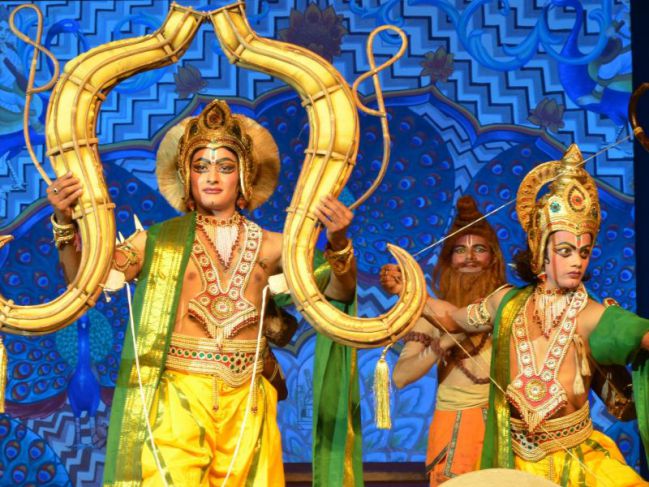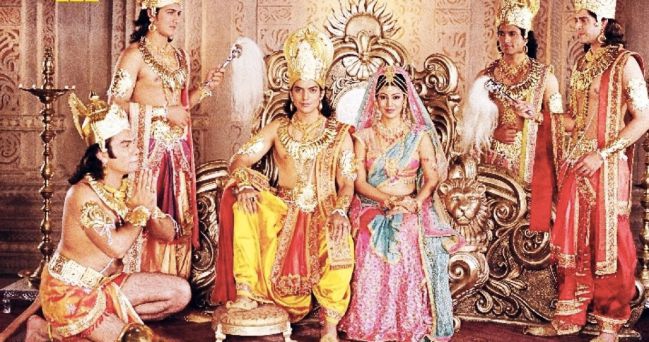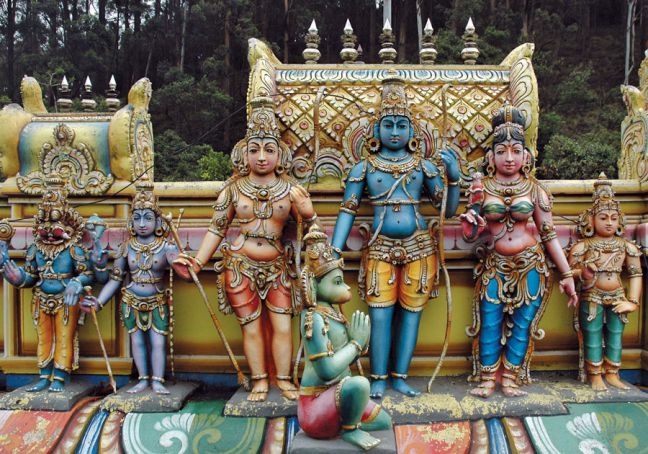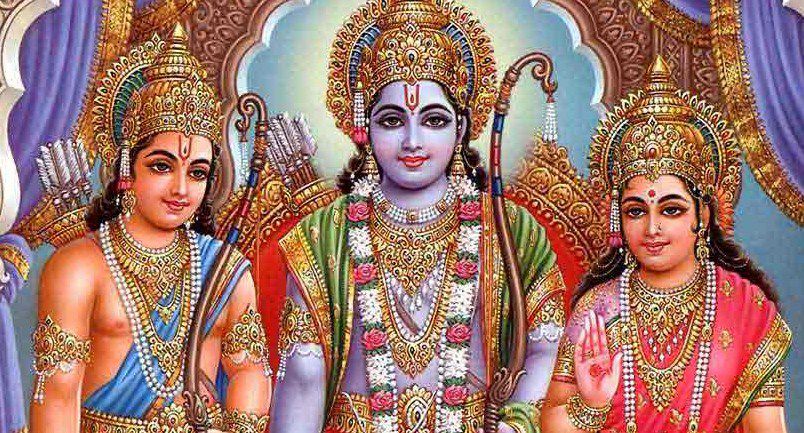No products in the cart.
The Hindu art, religion and cultural history have been primarily affected by two major literary works of ancient India: The Ramayana and the Mahabharata. The Ramayana has traveled through centuries and civilizations in the Indian origin and culture. Its influence has been on every living being not only in India, but also almost the whole of South-East Asia. The Ramayana has fervently carved out the building blocks of Hindu religion and its massively diverse culture. The Great Indian values and heritage owes its existence to Valmiki’s epic story. Even in today’s generations, the basic human ethics and values can be traced out back to the Ramayana. Ramayana can answer all our questions and problems of our present life. The solutions to our problems lie in following the ideologies presented in the epic.
In the field of Literature, many great writers have been influenced by Valmiki’s Ramayana. Even the masterpieces by the great Kalidasa, was inspired from Ramayana. Prominent impacts of Ramayana in his works can be seen in ‘Raghuvams’, ’Meghdoot’, ‘Abhgana Shakuntala’, ‘Vikramorvasiya’ and ‘Kumarasambhava’. Not only the epic, but
also its characters were adopted in literary works by writers and poets. Lakshmana Suri, a poet of the 19th century, delivered many great works based on Ramayana, such as the ‘Prapanna Vibishanam,’ ‘Paulastya Vadham,’ ‘Gayatri Ramayanam’ and the ‘Ramayana Sangraha.’ The Tamil poet, Kambar wrote Kambaramayanam in the 12th century, the Telegu poet, Gona Budda Reddy wrote the Ranganatha Ramayanam. The telegu poetess, Molla wrote Molla Ramayana,the 15th century Bengali poet Krittibas Ojha wrote Krittivasi Ramayana. The most popular poem inspired by Ramayana is its 16th century Awadhi version, Ramacharitamanas, written by Tulsidas.
Valmiki Ramayana’s profound impact across the civilizations can be highlighted in the fact that the epic has led to the production of numerous Ramayanas, almost 300 creative works spanning across the cross sections of a variety of regions, languages and countries. The Ramayana has been adapted suiting to the local conditions. If people think that the effect of Ramayana is only restricted to India, or South-East Asia, think again! The huge volumes of research work done on Ramayana is incredible in its own sense. There is an unending list of translations available on Ramayana in a variety of languages, even Arabic and Uzbec. The travelers, sailors and traders across the times have spread the knowledge, principles and values of the great Indian masterpiece. Thus, we see that the Ramayana knows no bounds, constraints and barriers of language, borders, and diversities. Ramayana has risen above them through the ages, proving that it is more than just another work of literature. It pertains to the lives of human beings, their moral values and ethics.
Ramlila – A Stage Play Popular World Over

In India, the influence of Ramayana is not just restricted to literary works. We Indians are well familiar with the popular stage play, Ramlila, which re-enacts the Ramayana. The history of Ramlila dates back to the 17th century when the first Ramlila show was staged by Megha Bhagat, one of the disciples of Tulsidas, the writer of Ramacharitramanas, however some historians believe that it was first staged between 1200 and 1500 AD. Over the civilizations, Ramlila has transformed a lot, and its reach has touched all corners of the globe. Even today Ramlila shows are performed in countries like United States, Canada, Mauritius, Netherlannds, and Australia. In 2005, The UNESCO declared the Ramlila to be a Masterpiece of the Oral and Intangible Heritage of Humanity. Indians still celebrate festivals like Diwali, by enacting Ramlila. The right mix of humor and grandeur in Ramlila makes the joy of festivals manifold times, especially when celebrated with all people in the community. Many prominent parks in India are named after Ramlila as the play is performed there at least once a year.
Movies Inspired from Ramayana
In the 20th century India, many movies were made based on the Ramayana. One of the first was Sampoorna Ramayana, a Telegu movie in 1958. In 1961, Sampoorna Ramayana was remade to a Hindi film by Babubhai Mistry, while the name of this mmovie was kept the same. Following is the chronological order of movies released in India on Ramayana:
- Lava Kusha – 1963, Telegu Movie
- Kanchana Sita – 1977, Malayalam Movie
- Ramayana: The Legend of Prince Rama- 1992, Japanese animated film releases in Hindi, English and Japanese languages.
- Sita Sings the Blues – 2008, English animated movie
- Lava Kusa: The warrior Twins – Animated film, 2010
- Ramayana: The Epic – Warner Bros. Indian animated movie,2010
- Sri Rama Rajyam – 2011, Telegu film based on Uttara Kanda
- Mumbai Musical – 2016, Dream Works Animation

The Ramayana movies were not as much as a hit, as much the Indian TV series based on Ramayana, which started coming into the scene since 1986. Even today new TV series are being created based on Ramayana. The first TV series, Ramayana was originally broadcast on Doordarshan, in 1986. This TV series was a major hit of its times. Almost every family with a TV in their house used to wait for the broadcast of Ramayana once a week, along with the members of the neighborhood joining to have a great time. Next came Jai Hanuman, which was also broadcast on Doordarshan. The following is the chronological order of the release of Indian TV series based on the epic:
- Ramayan(2002) – 2002, broadcast on Zee TV
- Ramayan(2008) – 2008, originally broadcast on NDTV imagine
- Ramayan(2012) – Remake of 1987 Ramayan
- Antariksh – 2004, A sci-fi reproduction of Ramayan, originally broadcast on Star Plus
- Raavan – Series based on Raavan, originally broadcast on Zee TV
- Sankatmochan Mahabali Hanuman – 2015, Based on life of Hanuman, originally broadcast on Sony TV.
- Siya Ke Ram – 2015, a series based on Rama’s life from Sita’s point of view, originally broadcast on Star Plus.
Ramayana’s Influence on Art
The Ramayana has also greatly molded the art and architectural works of India throughout these centuries. Even in modern art work, it has been depicted in many forms of art work. One notably popular painting is the one by the Malaysian artist Syed Thajudeen in 1972. The painting showcased Ramayana tales, Sita’s Abduction, Hanuman’s visit to Sita, and Hanuman burning Lanka, in 16×178 inches. The Pahari Ramayana paintings in the Seth Kasturbhai Lalbhai collection are also well renouned art works based on stories of Ramayana.

Many temples in South India are associated with Rama, like the popular Seetha Ramachandraswami temple in Bhadrachalam, Andhra Pradesh. Other popular temples include the Rama temples in Maduranthakam and Ponpadirkudam near Chinglepet, Tamil Nadu, the Hazar Rama temple in Hampi, Karnataka. The narratives of Ramayana can be seen in Virupaksha temple in Pattadakal. The Ramayana has always been a very popular theme amongst temple sculptors in India. The Thanjavur district located in Tamil Nadu also has many popular temples and inscriptions dedicated to Lord Rama. Some of them are the Sarangapani temple, Nageshvara Temple, Airavateswara temple, Ramaswamy temple, the Adi Kumnheshwara temple, and the Navegraha temple. There is an image of Rama made of bronze which has ‘Dharba Sayana Rama’ inscribed on its crown and ‘Tirupalli Setu Rama’ inscribed on its base. These bronze images are present in the Rama temples Ponpadirkudam near Chengalpet.
Another area where the Ramayan’s works of art are visible is in the Pillars of Vishnu temple, which consists of the forms of Hanuman and Hanuman’s ever faithful devotion to Lord Rama.
The Ramayana has affected the Musical and poetic compositions of Indian history. The original work of Ramayana itself was taught in verses to Luva and Kusha by Valmiki. They spread the Ramayana in songs as they were good musicians. The Ramayana is set to musical notes, and thus have strongly influenced the musical composers who sang in praise of Lord Rama and his fellow companions. Some songs have lyrics which have narrate the entire story of Ramayana, like Rama astapadi of Rama kavi of Tiruvisainallur, Namo namo raghukula of Annamacarya, Suddha brahma paratpara ram, Ramachandraya of Muthusvami Diksitar, Bhavayami of Svati Tirunal, Ramacharitra geetam of Papanasam Sivan,etc.
Thus we see that Ramayana has influenced through the cross section of Indian art and architecture. Every field of art and culture has footprints of Lord Rama and his great tales.
The great Hindu epic, Ramayana teaches Indians the idealistic way and manners of living life, for a peaceful and eternal existence. It contains the magnanimous knowledge of philosophy, customs and religions, polity, social life, religion, ethics, code of conduct, etc.
Each character of Ramayana teaches us different moral values and ethics required for the smooth functioning of human beings. Each character stands as symbols of love, compassion, piety, patriotism, sibling love, respect for parents, selflessness, etc. The characters of Urmila and Sita stand for ideal womanhood while Rama and Lakshmana teach us the meaning of true brotherhood, and sacrifice. The character of Ravana teaches us how arrogance can ruin a man, even after acquiring all the knowledge of the world. His evil intentions and impure ambitions led to his destruction by Lord Rama. The festival Dussehra is celebrated in India as a symbol of the victory of good over evil.







Ramayana has had a lasting impact on Indian art and culture. The Ramayana, is the Adikavya, i.e., the first poem. That does not imply that there were no poetry before, but that it is the first work of poetry that depicts all the topics and characteristics expected of a great work of art. It could also be said that the Ramayana set the standard for a great poem. Besides, it is a Dharma Shastra, an authority on right conduct. It is the story of Lord Ram, the Maryada Purushottam – noblest man, and that makes it a guide manual for righteous life.
Dharma Shastra has four arms – Tapas, Saucha, Daya and Satya i.e., austerity, chastity, charity and honesty. Lord Ram in Ramayana demonstrates each of the four arms. Rama by doing this has set the example for Hindus to follow and emulate.